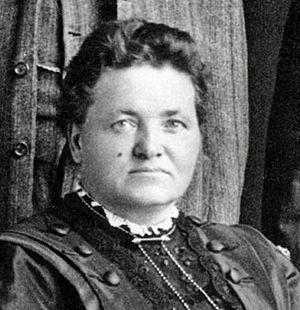Harriet Morison facts for kids
Quick facts for kids
Harriet Russell Morison
|
|
|---|---|

Harriet Russell Morison, 1911
|
|
| Born | 1862 Magherafelt, County Londonderry, Ireland
|
| Died | 19 August 1925 (aged 62–63) New Lynn, Auckland, New Zealand
|
| Nationality | New Zealander |
| Occupation | tailor, trade unionist, factor inspector |
| Known for | trade unionist, feminist |
Harriet Russell Morison (born 1862 – died 19 August 1925) was an important New Zealander. She started as a tailor. Later, she became famous for helping workers get fair treatment. She also fought for women's right to vote and worked for the government.
Contents
Harriet Morison's Early Life
Harriet Morison was born in Magherafelt, Ireland, in 1862. When she was a child, she moved to New Zealand with her parents. They settled in a city called Dunedin. Her father was a master tailor, which means he was a skilled clothes maker. Harriet followed in his footsteps and became a tailor herself.
Fighting for Workers' Rights
Harriet Morison was a strong supporter of workers. She became a leader in New Zealand's first union for women workers. This union was called the Tailoresses' Union of New Zealand. It started in Dunedin in 1889.
- Harriet attended the very first meeting.
- She quickly became the union's vice-president.
- In 1890, she became the secretary, a role she held until 1896.
- She worked very hard to organize the union.
- Harriet traveled to other cities like Wellington and Auckland. She helped build up the union branches there.
- Thanks to her efforts, the union helped clothing workers get a minimum weekly wage. This meant they earned at least 7 shillings and 6 pence per week.
Campaigning for Women's Vote
Harriet Morison also strongly believed that women should have the right to vote. This is called women's suffrage. She felt it was a natural part of treating everyone equally.
- She helped organize first aid classes for women.
- She was also a founding member of the Women's Christian Temperance Union. This group worked to improve society.
- In 1892, she led a movement against Henry Fish. He was a politician who did not support women voting.
- With her friend Helen Nicol, Harriet started the Dunedin Franchise League. This group worked for women's voting rights.
- After women gained the right to vote, the League continued as a charity for women.
Harriet left her role as union secretary in 1896. There were some issues with record-keeping for events she organized. However, there was no proof that she did anything wrong.
Harriet's Later Life and Work
For 14 years, Harriet Morison regularly visited the Seacliff Lunatic Asylum. This was a hospital for people with mental health conditions. She cared deeply about the well-being of these patients.
- She was also active in the Bible Christian Church.
- She became one of New Zealand's first female preachers.
- She also chaired the Unitarian Church Committee.
In 1906, Harriet made history again. She became the first female factory inspector in New Zealand. She worked for the Department of Labour in the South Island. Two years later, she moved to Auckland. There, she managed a new branch of the Department focused on women's issues.
Harriet retired in 1921. She passed away at her home in New Lynn in 1925 after a period of poor health.
Harriet Morison is remembered as an important figure in New Zealand's history. She is one of six people honored at the Kate Sheppard National Memorial in Christchurch. This memorial was unveiled in 1993. It marked 100 years since women in New Zealand gained the right to vote.


